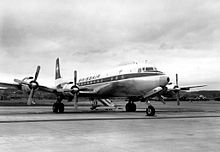
Back دوغلاس دي سي-7 Arabic Douglas DC-7 Czech Douglas DC-7 Danish Douglas DC-7 German Douglas DC-7 Spanish داگلاس دیسی-۷ Persian Douglas DC-7 Finnish Douglas DC-7 French Douglas DC-7 Frisian Douglas DC-7 Galician
| DC-7 | |
|---|---|

| |
| The DC-7 is a low wing airliner powered by four radial engines | |
| Role | Airliner and transport aircraft |
| National origin | United States |
| Manufacturer | Douglas Aircraft Company |
| First flight | 18 May 1953 |
| Introduction | 29 November 1953 |
| Retired | October 2020[1] |
| Status | Retired[1] |
| Primary users | American Airlines (historical) United Airlines (historical) Eastern Air Lines (historical) Pan Am (historical) |
| Produced | 1953–1958 |
| Number built | 338[2] |
| Developed from | Douglas DC-6 |



The Douglas DC-7 is an American transport aircraft built by the Douglas Aircraft Company from 1953 to 1958. A derivative of the DC-6, it was the last major piston engine-powered transport made by Douglas, being developed shortly after the earliest jet airliner—the de Havilland Comet—entered service and only a few years before the jet-powered Douglas DC-8 first flew in 1958. Larger numbers of both DC-7B and DC-7C variants were also built.
Unlike other far more successful propeller-driven Douglas aircraft, such as the DC-3 and DC-6, no examples of the DC-7 remain in service as of 2020.[1]
- ^ a b c Dwyer-Lindgren, Jeremy (28 October 2020). "As jets take charge of fire-bombing missions, the 62-year-old piston-powered Tanker 60 takes its last flight over Oregon". MSN. Archived from the original on 31 October 2020.
- ^ "Boeing: Historical Snapshot: DC-7 Transport". boeing.com. Retrieved 2 April 2018.
© MMXXIII Rich X Search. We shall prevail. All rights reserved. Rich X Search